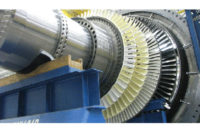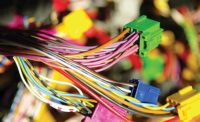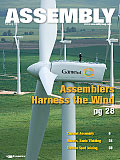
Wind power is the cheapest and most popular type of regenerative energy. Although the technology evolved in Europe, the United States has recently become the hottest market in the world for wind turbines. As a result, manufacturers are scram-bling to build gearboxes, generators, blades, power systems, motors, control systems and other types of electromechanical devices.
Wind power works by harnessing the breeze that passes over the rotor blades of a wind turbine and rotates a hub. The hub is connected to a gearbox via low-speed and high-speed shafts that drive a generator contained within a nacelle. A genera-tor converts the energy into electricity and then transmits it to a power grid.
The typical wind turbine is a slender structure that consists of a three-bladed rotor that extends up to 300 feet in diameter at-tached to the top of tall towers that soar hundreds of feet into the air. A yaw mechanism uses electrical motors to turn the nacelle with the rotor against the wind. An electronic controller senses the wind direction using a wind vane.
In addition to traditional horizontal wind turbines, vertical systems are available for smaller applications. They are intended for schools, libraries, office buildings, billboards and small businesses, in addition to residential use. Rotors that resemble egg-beaters catch wind from all directions and can operate at high torque in low winds.
Turbines are popping up around the United States, because wind power is widely touted as a clean, renewable, free source of energy that does not produce any carbon dioxide or other greenhouse gases. “Over the course of their minimum service life of 20 years, modern multi-megawatt wind turbines produce 40 to 50 times the energy used in their production,” claims Parveen Gupta, director of wind energy sales for North America at Bosch Rexroth Corp.
However, the industry is struggling to build a local supply chain. “The availability of a steady and sufficient supply of locally sourced components is [important],” says Jennifer Mapes, a wind industry analyst at the Freedonia Group Inc. “As turbine companies increasingly develop production facilities away from their home base, they need to be able to have access to enough quality components to build the systems at their new location.”
The American Wind Energy Association (AWEA) says soaring demand has spurred expansion of wind turbine manufactur-ing in the United States. It estimates that the share of domestically manufactured components has grown from less than 30 percent in 2005 to more than 50 percent in 2009.
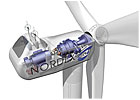
Blustery Market Conditions
According to AWEA, more than 1,000 wind turbines larger than 2 megawatts are already in commercial operation in the United States. But, that’s just the tip of the iceberg. The industry is expected to grow dramatically over the next two decades due to volatile oil prices, the worldwide push for clean energy and favorable government incentives.Today, wind power provides only 1.3 percent of the world’s electricity. But, BTM Consult predicts that 2,500 gigawatts of wind power capacity will be on line by 2030, representing 17 percent of total global electricity consumption.
The U.S. Department of Energy has issued an edict that calls for using wind energy to generate 20 percent of the country’s electricity demand by 2030. That would require 300 gigawatts of wind generating capacity. Achieving 20 percent wind en-ergy will require the number of turbine installations to increase from approximately 2,000 per year in 2006 to almost 7,000 per year in 2017.
To meet that ambitious goal, wind technology will need to evolve. Engineers need to make wind turbines larger, taller, less expensive, more reliable and more efficient. For instance, because wind turbine components undergo a tremendous amount of joint stresses and failures, numerous manufacturing issues must be addressed.
“We need to understand how big turbines respond,” says Jim Green, senior project leader at the National Renewable Energy Laboratory’s National Wind Technology Center. “Increasing their performance, reducing their loads, creating components that last longer-we’ll need to learn about all those things if we’re going to make more wind power.”
Green and his colleagues are currently studying how excessive force affects the load on a wind turbine’s moving parts and control systems. They’re examining aerodynamics, power characteristics, vibrations, system fatigue, acoustics and other key measurements.
“It looks very graceful and simple, but the aerodynamics of a wind turbine are harder to understand than an airplane or a heli-copter,” claims Lee Jay Fingersh, an NREL senior engineer.
“Close tolerances, the ability of components to withstand operation in difficult conditions, and the availability of quality ma-terials are all important challenges [facing engineers],” adds Mapes. “It is also a challenge to develop parts that are light-weight enough so that the final system can be assembled more easily, but they must also be durable enough to withstand dif-ficult operating conditions.
“For instance, blades, towers and casings must be able to withstand heat, cold, rain, ice and abuse from changing wind speeds,” Mapes points out. “Blades must also be built with a high strength-to-weight ratio, so research into [new] materials is key.”
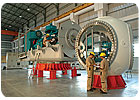
Robust Requirements
Most wind turbines are designed for a 20-year life cycle. The gearbox and drivetrain system must be strong enough to handle frequent changes in torque caused by changes in wind speed. Bearings are extremely critical. The whole system must be cor-rectly aligned to minimize wear from vibration and any resulting noise.“Wind turbines run many hours-the rough equivalent of running a vehicle 100,000 miles every year, so everything must be viewed through that lens,” says John Langdon, CEO of Viryd Technologies, a three-year-old company that is developing a new way to harness wind power. The startup’s chief engineer previously worked for Ford Motor Co. and Visteon.
“The complex relationship between design and manufacturing cost is unique in wind turbines, because of the focus on the cost of energy over the lifetime of the device,” explains Langdon, a former Texas Instruments executive. “Cost, durability and performance are of balanced importance.
“The key metric has to be the lifetime cost of electricity (COE), and all the product features and benefits have to be translated into how they affect COE for a particular application. All else being equal, lower parts count is always desirable.”
According to Langdon, making wind energy practical is a matter of maximizing efficiency and minimizing production cost. He and his colleagues are currently developing an 8-kilowatt turbine aimed at the small-scale wind market. The heart of the system is advanced drivetrain technology that incorporates a continuously variable planetary transmission.
One thing that differentiates wind turbine manufacturing from other industries is sheer size. All components, such as bear-ings, gears and generators, must be extra large and extra strong. Big parts and big plants are common in the indus-try.
“As the size of wind turbines [increase], components such as bearings and gearboxes become larger, making assembly and installation challenging,” says Elaine Chan, an analyst at Frost & Sullivan Inc. For instance, the typical gearbox weighs around 30,000 pounds.
“Due to their size and weight, gearboxes are moved through assembly steps at our plant in Germany using large rail systems similar to those in automotive plants,” says Gupta. “Quality expectations in the industry are huge, because manufacturers demand reliability and low maintenance. Wind turbines don’t make money if they’re not working.”
Reliability is critical in the wind turbine industry. “We’re promoting robust manufacturing,” says Jose Zayas, program man-ager for wind and water power technologies at Sandia National Laboratories, which has sponsored workshops on the issue. “Design for manufacturability will become more important as we move forward.”
To address reliability concerns, many wind turbine components are manually assembled with fasteners. “Fastening technol-ogy is mostly mechanical, with conventional bolts in various diameters,” notes Gerry Sorvino, industrial marketing manager at Alcoa Fastening Systems. “We see demand for M16 fasteners inside turbines, M36 in gears and monopole towers and M27 in lattice towers. All structural bolts are Class 10.9 and corrosion resistant to either ISO 12944 C4 or ISO 12944 C5 M.
“Most [wind turbine] components are assembled in limited volumes, by project, and are unique to each manufacturer,” says Sorvino. “The biggest challenge is torque control on large bolts and the interaction of adjacent bolts on clamp when tighten-ing heavy flanges together.
“We see the most difficult application as the gearbox, because it is important to avoid any distortion,” Sorvino points out. “The challenge is to maintain clamp loads for the service life of the turbine. Manufacturers are looking at weight reduction and improved assembly of threaded joints.”

Assembly Challenges
The average wind turbine contains up to 8,000 parts that must be assembled. Towers and rotors are the largest and most basic components.
Towers typically consist of large tubular structures. Plated steel sheets are rolled into rings and joined together with submerged arc welding. However, “developments in electron beam, hybrid arc and laser welding processes are being explored,” says Chris Bagley, power industry program manager at The Welding Institute (TWI). “The tower sections are typically fabricated into cans about 20 meter long and then bolted together through internal flanges.
“This is an industry that needs to build large, high-capital items in a production line manner,” explains Bagley. “In this respect, it may be compared to aerospace. However, the current players tend to have a traditional ‘project build’ approach and face a challenge in moving to become factories.”
According to Bagley, tower fabrication typically relies on mature assembly technology, but “there is great potential for advanced robotic welding to be developed.” On the other hand, blade manufacturing tends to be the most innovative and highly secretive area of the wind turbine industry.
Rotor blades are typically made from fiberglass and other composite materials. “[Manufacturers] are facing increasing component size and associated joining and mold technology issues,” says Bagley. “Blades over 70 meters [long] are now being designed.
“As well as having to join long lengths of blade [consisting of] leading and trailing edges to tight tolerances to assure aerodynamic conformance, [manufacturers] face a significant challenge in ensuring uniform resin spread when fixing the internal spars to the blade skins,” Bagley points out. “A lot of blades are made using hand lay-up. Automated solutions from aerospace or automotive, such as robotic tape layers, could be brought to bear here. Vacuum infusion techniques are starting to be used more widely.”
Traditionally, two-component epoxy adhesive has been used to bond the two halves of the blade together. “Over the past few years, manufacturers have become very interested in faster setting, less brittle adhesives,” says Brian Dorenkott, focus segment manager - alternate energy at Henkel Corp. “[We] anticipated these demands and developed two major new adhesive technologies.
“The two-component urethane family of products offers gap-filling capabilities, flexibility and cure speed adjustability,” claims Dorenkott. “The methyl methacrylate product family is very fast, reduces labor costs, and has outstanding strength and economics.”
According to Dorenkott, most wind turbine blades are assembled manually and adhesive is applied with putty knives. “Assembly is currently a very inexact process with imperfect quality control,” he explains.
As a result, some blade manufactures have begun to move toward automation. “The industry recognizes the need to automate the assembly process to achieve low-cost mass production,” says Frost & Sullivan’s Chan. “Companies like MTorres and MAG Industrial Automation Systems are currently pursuing the development of automation concepts and systems.” However, the design of the blade has to be changed to suit the process. A
To learn more about wind turbine technology, search www.assemblymag.com for these articles:
- Advanced Drivetrain Technology Makes Wind Turbines More Efficient.
- Circulation Control Technology May Improve Wind Turbines.
- Composite Blade Automation Is Starting to Emerge.
- Wind Turbines Demand Reliable Components.

